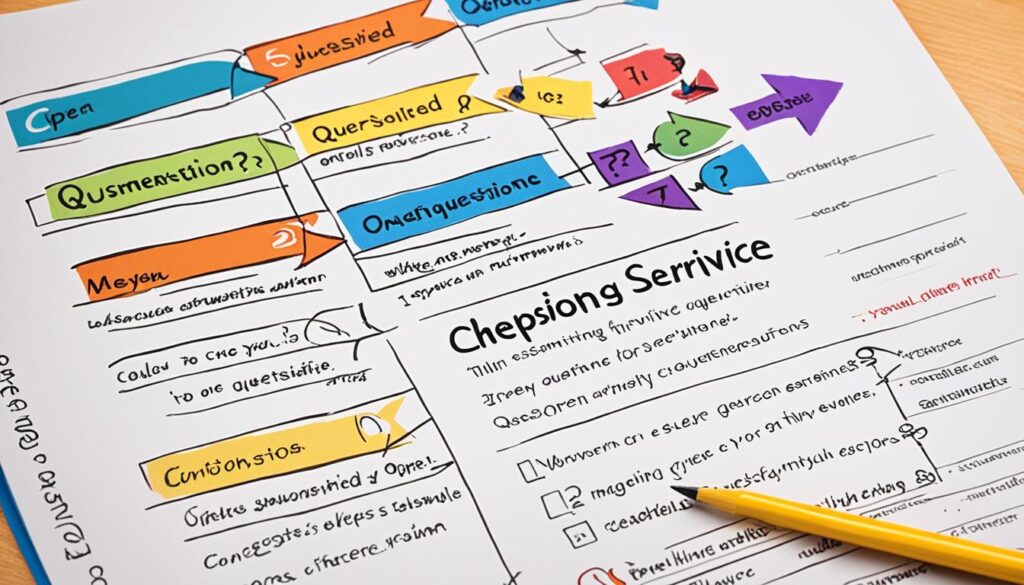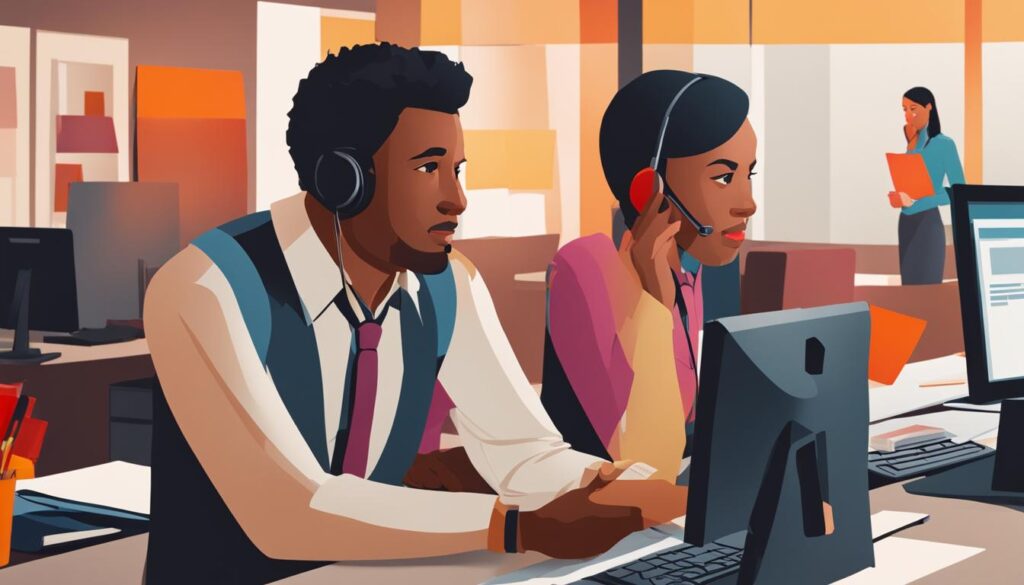Have you ever wondered how customer service professionals can uncover the root cause of a problem and provide personalized solutions? The secret lies in their skillful use of probing questions. In this article, we will explore the effective techniques of asking probing questions in customer service. By the end, you’ll be equipped with the knowledge to enhance your customer interactions and deliver exceptional support.
Types of Probing Questions in Customer Service
When it comes to providing exceptional customer service, asking the right questions is key. Probing questions allow you to delve deeper into customer issues, gaining valuable insights that can help you deliver personalized solutions. In customer service, there are four common types of probing questions that you can utilize:
1. Exploratory Probing Questions
Use exploratory probing questions to gather more information and gain a better understanding of the customer’s problem. These questions encourage customers to provide specific details and paint a clearer picture of their situation.
2. Investigative Probing Questions
When faced with complex issues, investigative probing questions help you dig deeper and uncover specific details. These questions allow you to unravel the underlying causes of the problem and identify the necessary steps to reach a resolution.
3. Confirming Probing Questions
Confirming probing questions are designed to ensure understanding and make the customer feel valued. By paraphrasing or summarizing the information provided by the customer, you convey that you have been actively listening and correctly comprehending their needs.
4. Leading Questions
In certain situations, leading questions can be used strategically to guide customers towards a desired action or solution. These questions suggest a specific answer and can help navigate the conversation in a way that prompts customers to think about alternative options or consider additional factors.

By incorporating these different types of probing questions into your customer interactions, you can enhance your problem-solving abilities, gain deeper insights, and provide tailored solutions that truly meet the needs of your customers.
The Importance of Probing Questions in Customer Service
Probing questions are vital in customer service for several reasons. They steer the conversation from focusing solely on the problem to finding a solution. By asking probing questions, customer service representatives can effectively address customer needs and enhance customer satisfaction.
One of the key benefits of probing questions is their ability to encourage customers to provide specific details. This is crucial for problem-solving as it allows customer service professionals to gain a deeper understanding of the issue at hand. By uncovering the root cause of a problem, representatives can tailor their solutions to meet the unique needs of each customer, resulting in higher customer satisfaction.
Probing questions also play a role in clearing up misunderstandings. By encouraging customers to think beyond their initial emotional response, these questions help bridge any communication gaps and ensure that both parties are on the same page. This facilitates a productive discussion that focuses on finding a resolution rather than dwelling on the problem.
Asking probing questions also enables customer service representatives to become better listeners. By actively engaging with customers and seeking additional information, representatives can address their concerns more effectively. This fosters a positive customer experience and builds trust between the customer and the company.

Best Practices for Asking Probing Questions in Customer Service
To effectively ask probing questions in customer service, it is important to apply certain techniques that engage customers and gather valuable information. By using open-ended questions, you encourage customers to provide detailed responses, offering insights into their needs and concerns. Specific questions help clarify ambiguous situations and uncover specific details, enabling you to tailor your solutions accordingly.
However, asking the right questions is just one part of the equation. Active listening is crucial in understanding the customer’s needs and emotions. By attentively listening to their responses, you can empathize with their situation and respond effectively. Avoid using leading questions that might sway the customer’s response, allowing them to express themselves freely. Furthermore, refrain from interrupting customers while they are speaking, as it can hinder open communication.
By adhering to these best practices, you can create a conducive environment for meaningful interactions with customers. Your open-ended questions, coupled with active listening, will elicit valuable insights and enable you to provide effective solutions that address their specific needs.
“Asking effective probing questions helps uncover valuable information that may otherwise go unnoticed. The key is to engage customers with open-ended questions and truly listen to their responses.”

When employing these techniques, remember that the goal is to facilitate productive and personalized conversations that lead to satisfactory outcomes for customers. Through effective probing questions and active listening, you can build stronger customer relationships, enhance their experience, and ensure their needs are met.
Probing Questions in Action: Examples and Techniques
Now that you understand the importance of probing questions in customer service, let’s explore some examples and techniques to enhance your problem-solving abilities. By using clarifying questions and leveraging the TED questioning technique, you can effectively gather information and provide targeted solutions that meet your customers’ needs.
Here are a few examples of probing questions:
- Can you provide more details about the issue you’re experiencing?
- How long have you been facing this problem?
- What specific steps have you taken to resolve the issue so far?
- Are there any error messages or codes that you’ve encountered?
- Can you describe the impact this problem is having on your workflow or productivity?
These are just a few examples of how you can use clarifying questions to dive deeper into the customer’s situation. Remember to actively listen to their responses and ask open-ended questions that encourage them to provide specific details. This will help you gain a comprehensive understanding of the problem and formulate effective solutions.
Another powerful technique you can use is the TED questioning technique:
The TED questioning technique involves using three types of questions: Tell me more, Explain why, and Describe to me. These questions encourage customers to expand on their initial responses and provide more context. By using the TED questioning technique, you can uncover underlying issues and gain a deeper understanding of the customer’s needs.
By incorporating these techniques into your customer interactions, you’ll be able to gather the necessary information to solve problems effectively and provide personalized solutions. Let’s see how these techniques come together in a real-life scenario:
| Customer Issue | Probing Questions Used | Solution Provided |
|---|---|---|
| A customer is unable to log into their account. |
|
|
In this scenario, the customer service representative uses probing questions to gather information about the customer’s login issue. By asking clarifying questions and employing the TED questioning technique, they are able to guide the customer towards a solution tailored to their needs.
By utilizing these examples and techniques in your customer service interactions, you’ll be equipped to handle a variety of problems and provide effective solutions. Now that we’ve explored how to put probing questions into action, let’s delve further into improving your skills in the next section.
Improving Your Probing Questions in Customer Service
To enhance your customer service interactions, it’s essential to improve your probing questions. By asking specific questions that prompt detailed answers, you can gather more information and provide better solutions to your customers. Here are some tips to improve your probing questions:
- Avoid leading questions:
Leading questions can bias the customer’s response and may not provide accurate information. Instead, ask open-ended questions that allow the customer to share their perspective without any influence.
- Practice active listening:
Active listening is crucial in understanding the customer’s query. Pay close attention to their words, tone, and emotions. This information will help you ask relevant follow-up questions and uncover deeper insights into their situation.
- Allow the customer to express themselves fully:
It’s important not to interrupt the customer while they are sharing their thoughts and concerns. Give them the space they need to express themselves fully. This will foster trust and a sense of being heard, allowing you to gather more information to provide effective solutions.
By implementing these improvements, you can create a more engaging conversation with your customers and gain valuable insights into their needs and preferences. Remember to ask specific questions, avoid leading questions, and practice active listening to enhance your probing techniques.
| Specific Questions | Avoiding Leading Questions | Active Listening |
|---|---|---|
| Ask questions that prompt detailed answers. | Avoid questions that may bias the customer’s response. | Pay close attention to the customer’s words, tone, and emotions. |
| Encourage the customer to provide specific information. | Use open-ended questions instead of closed-ended questions. | Ask relevant follow-up questions based on the customer’s responses. |
| Probe deeper to uncover underlying issues. | Avoid suggesting a particular answer. | Give the customer space to express themselves fully without interruption. |
The Benefits of Asking Probing Questions in Customer Service
Asking probing questions in customer service can have a significant impact on customer satisfaction. By gaining a deeper understanding of customers’ needs and concerns, representatives can provide personalized solutions that address their specific requirements. This personalized approach demonstrates a commitment to meeting customers’ expectations and enhances their overall experience.
Additionally, probing questions play a crucial role in rapport-building with customers. By actively listening to their responses and asking relevant follow-up questions, representatives establish a connection that goes beyond transactional interactions. Building rapport and trust creates a positive impression of the company and fosters long-term loyalty.
By utilizing probing questions, customer service professionals can offer personalized solutions that meet customers’ needs and exceed their expectations. This personalized approach not only improves customer satisfaction but also showcases the company’s dedication to delivering exceptional service.
| Benefits | Description |
|---|---|
| Enhanced Customer Satisfaction | By providing personalized solutions tailored to customer needs. |
| Rapport-Building | By actively listening and establishing a connection with customers. |
| Trust-Building | By demonstrating a commitment to meeting customer expectations. |
| Personalized Solutions | By understanding and addressing customers’ specific requirements. |
Overall, incorporating probing questions into customer service interactions provides numerous benefits, including improved customer satisfaction, stronger rapport-building, trust-building, and the ability to offer personalized solutions. By utilizing these techniques, customer service professionals can create a positive experience for customers, leading to increased loyalty and positive word-of-mouth.
Conclusion
In customer service, probing questions are an invaluable tool for understanding customer issues and providing effective solutions. By utilizing various types of probing questions, actively listening, and avoiding leading questions, customer service professionals can gather the necessary information to offer personalized assistance. Incorporating these effective techniques into your customer service interactions will not only enhance the customer experience but also build trust and improve overall satisfaction.
Asking probing questions allows representatives to delve deeper into customer concerns, uncover underlying problems, and tailor solutions to meet individual needs. This customer-centric approach fosters a positive and productive customer service experience, ultimately strengthening the relationship between the customer and the company.
By utilizing probing questions, customer service professionals can gain a comprehensive understanding of the customer’s situation, provide accurate and relevant solutions, and ensure that customer needs are fully addressed. This level of personalized support not only enhances customer satisfaction but also helps build long-term loyalty and advocacy.
FAQ
What are probing questions in customer service?
Probing questions in customer service are questions that customer service representatives ask to gather more information and understand the customer’s problem.
What are the types of probing questions used in customer service?
The types of probing questions used in customer service are exploratory probing questions, investigative probing questions, confirming probing questions, and leading questions.
Why are probing questions important in customer service?
Probing questions are important in customer service as they help steer the conversation towards finding a solution, encourage customers to provide specific details, clear up misunderstandings, and enhance the overall customer experience.
What are the best practices for asking probing questions in customer service?
The best practices for asking probing questions in customer service include using open-ended questions, being specific in your questions, practicing active listening, avoiding leading questions, and refraining from interrupting the customer while they are speaking.
Can you provide examples of probing questions in customer service?
Yes, here are some examples of probing questions that can be used in customer service:
How can I improve my probing questions in customer service?
To improve your probing questions in customer service, focus on asking specific questions that prompt detailed answers from customers, avoid leading questions, practice active listening, and allow customers to fully express their thoughts and concerns.
What are the benefits of asking probing questions in customer service?
The benefits of asking probing questions in customer service include higher customer satisfaction, building rapport and trust with customers, and providing personalized solutions based on a better understanding of the customer’s needs.
